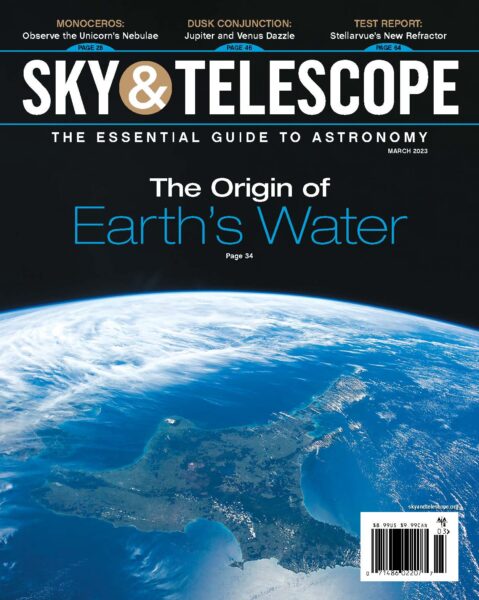
Earth’s Water, Spiral Galaxies, and the Southern Unicorn
In the March 2023 issue of Sky & Telescope, we’re diving into Earth’s vast oceans and asking: Where did they come from? Scientists long suspected that comets were the culprits, but now, carbonaceous chondrites have become the target of careful investigation. Then, we’re zooming out to take in a much bigger mystery, namely how galaxies get their spiral arms. And speaking of zooming out, we’re discussing how to adjust our imaging techniques to fit the latest cameras to hit the market. Once we’re all set up and ready to go, we’ll point those cameras at the light and dark nebulae of Monoceros, the Unicorn, as described in Richard Wilds’ article.
FEATURE ARTICLES:
Spiral galaxies are ubiquitous in the nearby universe, yet we still don’t know how their patterns arise.
By Monica Young
This subtle celestial spectacle is not only a wonder to behold, it also has some surprising uses.
By Thomas A. Dobbins and William Sheehan
Look toward Monoceros to find an eclectic collection of bright and dark nebulae.
By Richard P. Wilds
We live on a planet covered in water, but where did this water come from?
By Javier Barbuzano
Upgrading to the latest cameras may require changing your imaging techniques.
By Ron Brecher
Beyond the Printed Page:
Read about the first flight of the Artemis program.
Watch this rendering of classical density-wave theory.
Help transcribe thousands of logbooks and notebooks belonging to the astronomical computers and astronomers of Harvard College Observatory.
Check out Kazuhito Dobashi and colleagues’ “Atlas and Catalog of Dark Clouds Based on Digitized Sky Survey I."
ALSO IN THIS ISSUE:
The celestial Crab holds a misty, naked-eye treasure.
By Fred Schaaf
The brightest dwarf planet visits galaxies in Virgo during its upcoming apparition.
By Bob King
Hunting for Venusian Fireballs
Is it possible to see meteors on the nightside of our sister planet?
By Thomas A. Dobbins
Deep-sky treasures abound in the westernmost foot of Gemini.
By Ken Hewitt-White
Table of Contents
See what else March’s issue has to offer.
 0
0

Comments
You must be logged in to post a comment.